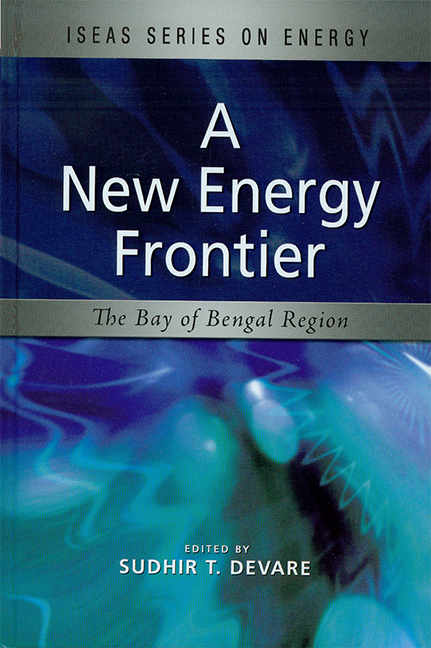Book contents
- Frontmatter
- Content
- Foreword
- Message from the Director
- Preface
- The Contributors
- 1 An Overview of the Energy Scene in the Bay of Bengal Region
- 2 Current and Expected Energy Production and Consumption within the Bay of Bengal Region: A Synopsis
- 3 Gas Potential at the Bay of Bengal and Implications for India's Energy Security
- 4 Macroeconomic Challenges for the Growth of the Energy Sector in Bangladesh in the Context of Regional Integration
- 5 Energy in the Bay of Bengal Region: Myanmar's Perspective
- 6 Marine-related Energy Resources in the Eastern Indian Ocean: Indonesian Perspective
- 7 Energy Trading and Singapore's Role as a Hub
- 8 Bay of Bengal: Awakening of a Potential Giant Area
- 9 Energy Transportation Security in the Bay of Bengal
- 10 Ethical Business Practice or Camouflage? Energy and Mining Companies and Corporate Social Responsibility
- 11 Sustainable and Renewable Energy: Scenarios for the Future
- Index
6 - Marine-related Energy Resources in the Eastern Indian Ocean: Indonesian Perspective
Published online by Cambridge University Press: 21 October 2015
- Frontmatter
- Content
- Foreword
- Message from the Director
- Preface
- The Contributors
- 1 An Overview of the Energy Scene in the Bay of Bengal Region
- 2 Current and Expected Energy Production and Consumption within the Bay of Bengal Region: A Synopsis
- 3 Gas Potential at the Bay of Bengal and Implications for India's Energy Security
- 4 Macroeconomic Challenges for the Growth of the Energy Sector in Bangladesh in the Context of Regional Integration
- 5 Energy in the Bay of Bengal Region: Myanmar's Perspective
- 6 Marine-related Energy Resources in the Eastern Indian Ocean: Indonesian Perspective
- 7 Energy Trading and Singapore's Role as a Hub
- 8 Bay of Bengal: Awakening of a Potential Giant Area
- 9 Energy Transportation Security in the Bay of Bengal
- 10 Ethical Business Practice or Camouflage? Energy and Mining Companies and Corporate Social Responsibility
- 11 Sustainable and Renewable Energy: Scenarios for the Future
- Index
Summary
INTRODUCTION
The Indian Ocean with average depths of 3,900 metres is the third largest ocean in the world, covering an area of more than 69 million square kilometres, or about 20 per cent of the Earth's water surface. It is bounded on the north by southern Asia; on the west by the Arabian Peninsula and Africa; on the east by the Malay Peninsula, the Sunda Islands, and Australia. The ocean is nearly 10,000-kilometre wide at the southern tips of Africa and Australia, but it spans 5,500 kilometres between Africa and Indonesia at the equator. Indonesia borders it on the east, but in the south, it opens wide facing Antarctica. The largest depths of the Indian Ocean floor are found in Java Trench and in Wharton Basin that exceeds 7,250 metres and 6,000 metres, respectively.
The ocean floor of the Indian Ocean is dominated by the Mid-Indian Ocean Ridge consisting of the Southeast Indian Ocean Ridge, Southwest Indian Ocean Ridge, and Ninety East Ridge. It reflects a long and complex history of plate dynamic since the Mesozoic. Plate interaction in the eastern boundary, namely Indo-Australian plate, Eurasian plate and Pacific plate, has produced numerous sedimentary basins in the area presently known as Indonesia. Some of these basins are proven to contain coal and hydrocarbon. In addition, tectonic plate interactions in the eastern boundaries have produced chain of volcanoes along the active margin involving magmatic and hydrothermal processes that potentially can be tapped as non-conventional energy resources.
At present and probably in the years to come, hydrocarbon and coal still are prime sources for energy in the world since the contribution of other energy types to the energy mix is still low. Large reserves of hydrocarbons are being tapped in the offshore areas of Saudi Arabia, Iran, India, Indonesia and Western Australia. An estimated 40 per cent of the world's offshore oil production comes from the Indian Ocean. However, the price of oil keeps increasing, and it seems that the era of low oil price is over. As energy demand increases due to better economic conditions, an unstable supply of energy resources due to security and political reasons in producing economies has to be considered as potential problems in the near future.
- Type
- Chapter
- Information
- A New Energy FrontierThe Bay of Bengal Region, pp. 112 - 127Publisher: ISEAS–Yusof Ishak InstitutePrint publication year: 2008



